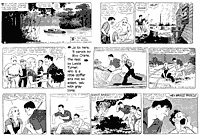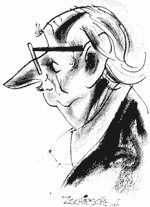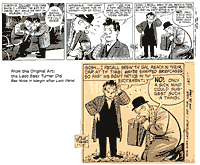|
Roy Crane's niche in comics history routinely overshadows
that of his one-time assistant, Leslie Turner, but Turner's place
is every bit as unique. Our Hindsight Department has a longish segment
on Roy Crane and his seminal role in the history of the medium (which
you can get to by clicking here).
For the moment, however, let me just brush by the main points in order
to get to Turner and his place in the saga of Captain Easy and in
the history of cartooning. Despite the praise Crane has received in
recent years, he is still undoubtedly the most unsung of the cartoonists
who shaped the medium. His historic achievement was to set the pace
for adventure strips in the thirties by showing the way in the twenties.
Many of those who drew the earliest adventure strips were inspired
and influenced by his work. We recognize the milestones in the history
of comics that mark the accomplishments of such creators as
Chester Gould, Noel Sickles, Ham Fisher, Zack Mosley, Milton Caniff
—even Mel Graff. But we forget that Crane preceded them all onto the stage
they later filled with their presence. And most of them, as they felt
their way in developing adventure storytelling skills, looked to Crane
for hints about how to do it. Crane's magnum opus, Washington Tubbs II, began Arriving
on Crane
had been experimenting for years with ways of giving his pictures
different textures and tones. Late in 1936, he chanced upon Craftint
doubletone, and within six months, he had adopted exclusively this
method of achieving tonal effects. Doubletone illustration board is
a chemically treated drawing paper. By applying a foul-smelling liquid
developer with a brush or pen, an artist can make fine lines or tiny
dots appear. The lines Crane brought out created two patterns: parallel
diagonal lines or cross-hatching. In reproduction, the diagonal lines
gave a drawing a light gray tone; the cross-hatched lines, a dark
gray tone. Crane had dabbled briefly with the use of Ben Day shading
as early as the spring of 1936. Ben Day shading, a gray tone of tiny
dots created mechanically in the photographic stage of reproduction,
produced a single, uniform gray tone. Crane used it sometimes alone,
sometimes augmented by hayey cross-hatching with a pen. During 1936,
he would deploy every method he could think of for creating variety
in texture and tone—grease crayon, splattered ink, Ben Day, and cross-hatching
and shading with a pen. He was searching. And once he found Craftint
doubletone, the quest was over. With twice the gray-tone capability
of Ben Day, Craftint was clearly the superior product. By April 1937,
Crane was using doubletone on a daily basis. Grease crayon and all
the other textural effects were abandoned for good. With
Craftint doubletone, Crane created some of the most beautiful scenes
in comics. With solid black as a third "tone"—progressively,
the darkest of the three—he produced pictures with photographic gradations
of gray, giving his strip a visual depth no other strip on the funnies
pages had. He is noted for the exquisite delicacy of shade and tone
in his outdoor scenes. Distant objects, he rendered in the lightest
gray tone; closer to the camera, he added the dark gray. With
doubletone, he could give the backgrounds against which he played
out his stories a photographic realism—dramatic seascapes, moody wind-swept
swamps, majestic mountain ranges, brooding jungles festooned with
foliage and vines and mysterious shadowy somethings. As always, the
realism of the settings added an aura of actuality to the otherwise
sometimes fantastic events. Just
about the time he had mastered doubletone, Crane acquired a full-time
assistant. Some of the work on the strip had been done, until then,
by an NEA bullpen artist, but that personage had apparently been assigned
to other chores, leaving Crane to draw everything himself. That, doubtless,
was a jolt. Whatever the case, sometime in the summer or early fall
of 1937, Crane wrote to an old friend, a fellow Texan who'd been born
two years earlier than Crane and 80 miles away, and asked him if he'd
help him out on the strip. Despite the proximity of their birthplaces,
Roy Crane and Leslie Turner didn't meet until they were both grown
men. Turner,
in a letter to cartoonist and collector Bob
Bindig, recalls those times: "Roy Crane and I were close
friends since 1920 when we met at the Crane
started at "a few colleges" (as Ron
Goulart puts it in his Adventurous
Decade) in Crane had been doing the strip for
nearly fourteen years without a break. It was a grueling pace--albeit
no different than that endured by every syndicated newspaper cartoonist.
The only way a syndicated cartoonist got a vacation in those primitive
times was by working twice as hard: if a cartoonist drew two weeks'
worth of strips in one week, he could take the next week as vacation.
By 1937, Crane needed a rest. He wanted to escape the deadline-meeting
ordeal for an extended period—say, six weeks—without having to double
his rate of production. He could do it if he had an assistant who
could draw enough like him to sustain the strip. His old friend Turner
was his choice. "His strip was always my favorite
by far," Turner wrote, "—the real pioneer of adventure strips
with enough humor sprinkled through his stories to add reader interest.
He was an excellent artist, and fast—with the right amount of exaggeration
to be most effective. When he called me in 1937 to ask if I'd draw
his daily and Sunday for six weeks while he took a much needed rest
in Turner, who had been making a good
living as an illustrator, had to learn how to draw cartoony pictures,
and he had to learn on the job. He told Goulart that the toughest
part of the assignment was learning to draw with a pen again after
using a brush for years. And Crane's style, a combination of big-foot
cartoony and realistic rendering, was not easy to imitate. On the
one hand, it was deceptively simple: an imitator could err by veering
too much in the direction of big-foot comedy. On the other hand, realistically
drawn wrinkles in clothing could seduce an imitator into producing
drawings that were too realistic. Turner, learning the craft as he
went, was bound to produce work at first that wasn't equal to Crane's.
Turner was feeling his way. Some recent observers, historian Bill
Blackbeard chief among them, complain of a "stiffness" in
the drawings. That, I submit, is the hallmark of realistic rendering
as opposed to cartoony rendering. Crane's big-foot style permitted
him to exaggerate movement: when his characters ran, for instance,
their knees came up almost to their chests. This treatment gave his
drawings great energy. But realistically drawn people do not seem
as energetic. In real life, when people run, their knees do not come
up to their chests. And an illustrator attempting to render people
running realistically would not draw them the way Crane did. They
would be drawn without Crane's exaggeration. And they would therefore
not seem as full of energy as Crane's people did. The drawings Turner
made in the fall of 1937 were
not as exaggerated as Crane's. They're realistic. And they therefore
seem Wrote Turner: "When Crane described the way he and Turner
divided the production chores: "We each had our specialties.
I did the writing, drew all of the Sunday, all water and action on
the daily, while he drew girls, aircraft, etc. The strip sprang back
to life." In the early days, according to Turner, it wasn't quite
that clean-cut a division of labor: "For the first few years,
In the early spring of 1943, Crane
left NEA to create a new strip for Hearst's King Features. It was
the old story: Hearst offered Crane a sweeter deal (including, I assume,
ownership of his feature). Crane was only the second major cartoonist
in the medium's history to leave a successful feature to create an
entirely new one. (The other rebel had also been an NEA cartoonist—Gene
Ahern, who had abandoned Major Hoople in Our
Boarding House to create a similar feature, Room
and Board with Judge Puffle, for King in 1936.) On November 1,
1943, Crane's Buz Sawyer debuted. Crane had expected
Turner to join him on the new strip, but NEA presumably made him a
better offer to stay on and continue Wash
Tubbs over his own signature, which he did, his first solo work
appearing May 31, 1943. Turner is one of the few cartoonists
to continue another's creation successfully—equaling and sometimes,
as Goulart says, surpassing his mentor's achievements. Turner's Wash Tubbs (which became Captain
Easy, finally, in 1949) was every bit as lively and exciting as
Crane's Wash Tubbs had been. At the same time,
Turner evolved a style of his own—derivative of Crane's but different,
too; distinctive. He continued using Craftint doubletone—which by
this time was a hallmark of the strip and of which he was as much
a master as Crane. In fact, many of the Wash
Tubbs panels printed in history books about the medium to illustrate
Crane's artistry were probably created by Turner. Visually, however,
Turner's strip was darker than Crane's: Turner made more lavish use
of solid blacks. And his linework was bolder, his strokes more fluid.
I'm not trying to debunk Crane's reputation
here. I'm not saying that Crane has been given credit all these years
for something he didn't do. I'm not saying that he did not develop
the technique for which he is acclaimed. I'm sure he did. But I am
saying that Turner was with him from 1937 on, so Turner undoubtedly
had a hand in creating that technique. Given the long-standing friendship
between the two artists and (judging from Crane's testimony as well
as Turner's) the way they worked together, it would be surprising
if Turner did not, on occasion, apply the doubletone developer to
the illustration boards himself. Joining Crane in 1937, Turner is
rightfully entitled to enjoy some of the credit that has been lavished
entirely on Crane all these years. "For about the first two years," Turner
said, "Russ Winterbotham wrote the stories, with me gradually
taking over the writing by 1945. Since I was never as interested in
straight adventure stories as in writing comedy, I began to place
more emphasis on the latter in most continuities, hopefully without
the change being too apparent." Turner stayed with Captain Easy until 1969—and here's his last strip, which, he says
in the marginal note, he completed November 28, 1969 for publication
January 15, 1970. Ultimately, Turner's reputation will
rest on his solo work on Wash
Tubbs and Captain Easy.
Ironically, Crane's reputation also rests largely on his first strip. Crane's Buz Sawyer was another masterpiece of doubletone shading, and the
pace and the action were in the tradition Crane himself had established.
But Buz Sawyer is a younger man than Easy. Taking advantage of the
opportunities for action and adventure offered by World War II, Crane
put Buz in the Navy. The strip remained a military strip for most
of its run, with Buz in Naval Intelligence after the War. In the postwar
strip, Crane sometimes echoed the light-hearted operetta ambiance
of his prewar ramble with Wash and Easy but never with quite the same
free-wheeling effect. Buz Sawyer was an accomplished piece of work by a master of the medium,
but Crane broke little new ground here compared to the vistas he had
opened in the 1930s. Curiously, by the time Buz
Sawyer was launched, the tables of inspiration had turned: Crane
was now clearly influenced by a cartoonist he once inspired, Milton Caniff. Buz, like Caniff's Terry, is a pilot. And Crane now
strove for authenticity in military details with the same zeal as
Caniff. And when Crane conjured up a beauteous sultry female guerrilla
leader in the South Seas and gave her the code-name Cobra, the character
(not to mention the serpentine
nom de guerre) cannot help but evoke comparisons with Caniff's
celebrated Dragon Lady. Later, Crane also introduced a blonde bombshell
in the mold set by Caniff's Burma. Crane's work continued to be impressive
in its own right, too, but Buz
Sawyer never had the magic that animated Wash Tubbs in those halcyon prewar years. Crane was doubtless not
as intrigued by the character of Buz Sawyer as he had been by Captain
Easy. When creative artists are stimulated by their creations, they
do their best work. And while Buz
Sawyer was by no means any kind of a slouch of a strip, it lacked
the fire of Crane's earlier achievement. The invigorating excitement
of discovery, of innovation day-by-day in a medium not yet fully formed,
wasn't there at the drawingboard anymore. Buz Sawyer was the work of a master who
knew all the tricks of his craft and who put his performers through
their paces with the sangfroid
of an experienced ring master, an old trouper who never made mistakes
because he had seen and done it all before. Cartoonist Bob
Zschiesche, who knew Crane and Turner during their Florida years
(and drew the caricatures of them that accompany this dissertation),
believes Wash and Easy enjoyed a place in Crane's heart that Buz never
approached: "The last drawing Roy drew," he wrote, "—a
week before he died—was of Wash and Easy in Jim Ivey's
Wash Tubbs book, which Roy sent to Dick Moores in Asheville, North
Carolina. I got the feeling he took greater delight in his Wash Tubbs
work. Perhaps he felt that in the early days the comics looked their
best in six- or seven-column wide format. 'In the early days,' Roy
said, 'cars and planes were more simply designed—and a cartoonist
could make 'em look funnier. The cars today, they're big, wide, enclosed
things. You can't do a thing with 'em!'" In the 1930s, illustrators would make the adventures in
comic strips seem more real with pictures that accurately depicted
enclosed automobiles—not to mention jungles and space ships, soaring
skyscrapers, office furniture, ladies fashions, people in general,
and every other thing under the sun. But before illustrators brought
serious authenticity to comics, there was Roy Crane. And it was the
work of Roy Crane—those often funny stories of treasure hunts and
melodramatic villainy and pretty girls and a hook-nosed soldier of
fortune—that an entire generation of cartoonists sought to equal as
they invented and refined the adventure comic strip. All of them,
like Crane, were seeking adventure for the fun of it. Leslie Turner
was among the very best of them.
|
||




